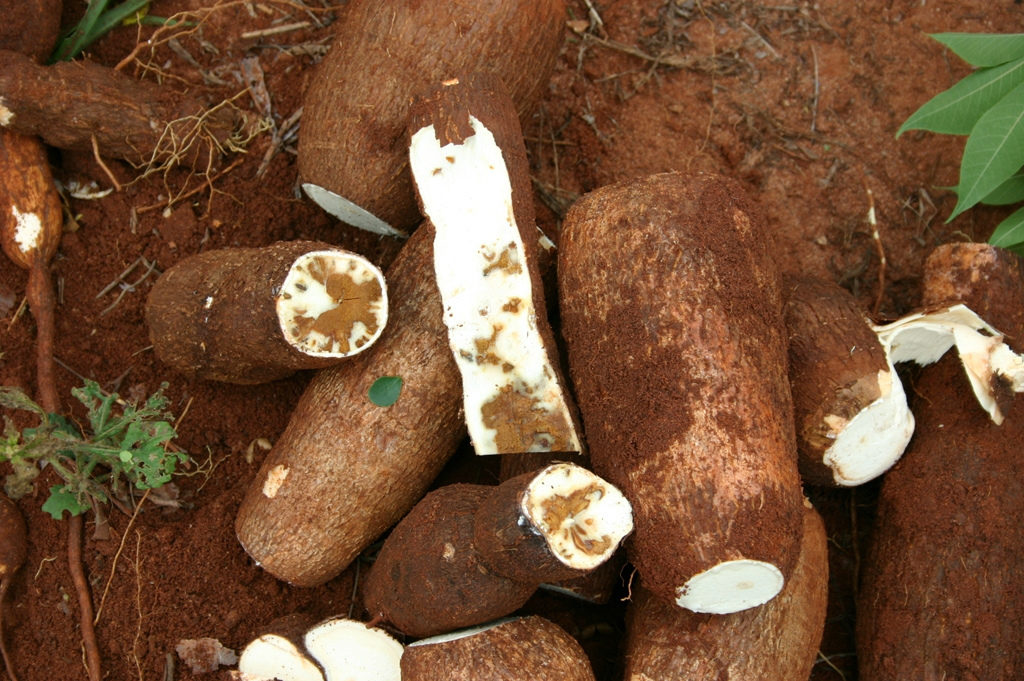Cassava or Yuca or Manioc, a perennial woody shrub with an edible root, is the third most important source of calories in the tropics. In the situation of economic and climate uncertainty world’s community is looking for more diversified base for food security, apart from the three staple crops, rice, wheat and maize. However, it has often been neglected in agricultural policies and has received considerably less emphasis in biotechnology and genetic improvement than other major staple crops. As a result, its commercialization and industrialization is relatively low and, hence, cassava products lack competitiveness. It is traditionally a crop cultivated by smallholders with low incomes.
Every Cloud has a Silver Lining
Although cassava is a good source of carbohydrate and calcium as well as vitamins B, C and minerals, it has relatively poor nutrition value, reduced shelf life, susceptibility to inbreeding depression while being prone to pests and diseases. It requires labor intensive harvesting and post harvest processing. Cassava roots also contain cyanide and must be processed shortly after being harvested otherwise cyanide concentration increases which can lead to health issues among consumers. Various processing methods, such as grating, sun drying, and fermenting, are used to reduce the cyanide content.
On the other hand, cassava is extremely versatile. It is used for production of food, confectionery, sweeteners, glues, polywood, textiles, paper, biodegradable products, monosodium glutamate, cosmetics and pharmaceuticals. Cassava chips and pellets are used in animal feed and alcohol production. It is also a suitable crop for bio-fuel industry. What is more, it is dry resistant, can be grown in poor soils and does not require a lot of inputs which makes it cheap to produce and attractive in the face of changing climate. Additionally, its leaves can be used for food too and the stems can be turned into wood for cooking. So, it is not a big surprise that people in Uganda say “wamalako nga Muwogo” (complete as cassava).
Recognized Importance
In 2001 significance of cassava was acknowledged by FAO in the form of Global Cassava Strategy in which this crop has been envisioned as stimulus for rural economic development and food security contributor. In order to develop full potential of cassava industry, the strategy suggests using “industry analysis” that identifies opportunities and constrains at each stage of supply change. Recently conducted research by Swedish University of Agriculture Sciences (SLU), presented at The SLU Global Food Security Research Symposium, echoes FAO Global Cassava Strategy and aims at understanding of proper management of cassava industry for enhanced food security.
Learning from the Roots
An interdisciplinary study, “Cultivated Diversity and Farmers’ Knowledge – Keys to Cassava Breeding” was conducted by SLU, the Linnean Center of Plant Biology and the Vietnam Academy of Agricultural Sciences. It consists of two parts. The first part is a comparative study between Vietnam and Uganda which revealed that cassava breed diversity per farmer is considerably higher in Uganda than in Vietnam. Farmers in Uganda cultivate local and improved varieties on different plots and use local sweeter varieties for food. Improved varieties are bitterer, which means that they have higher cyanide content. They are used for animal feed, ethanol production and starch, which is sold either through retailers or directly to the market both in fresh and dried form.
The second part of the study stems from the assumption that although cassava can be grown in rain-fed and low-input agrosystems, it degrades soil. That is why the possibility of the beneficial root symbiosis with arbuscular mycorrhiza, member of an ancient phylum of fungi family, for soil fertilization was examined. DNA sequencing revealed novel taxonomic units as well as known mycorrhiza species and differences in relation to soil. The project contributes to understanding of desired breeding goals for farmers, their use of local varieties and adoption of improved varieties.
How Human Geography Defines Industry Development
Another project on cassava, presented at the Symposium addressed expansion of cassava production and commercialization. The study is a result of collaboration between SLU, Department of Human Geography in Lund University and several partners from Zambia, Ghana, Denmark, Netherlands, USA, Uganda and Malawi and is called “Cassava commercialization – Adding Value through Product Development”. The overall aim of the research was to clarify how expanding cassava production enhances commercialization along the value chain. The results suggest that emergence of cassava markets goes slow in Southeastern Africa because the region’s main cassava production zones lie far from major food processing industries, that mostly are located in capital cities. Additionally, there are health risks related to transportation of cassava that come from cyanogenic glucosides content, so it is preferable to allocated processing close to cultivation sides. The study points out the difference between cassava production in West Africa, where urban demand facilitated development of affordable processing technologies, and Southeastern Africa, where cassava is mostly utilized in fresh form for production of low value-added cassava flour and industrially processed cassava-based starches, bio-fuels and feeds. However, more research is needed to characterize the biochemical properties of the different cassava varieties and the mapping of their possible applications for industrial production both inside and outside the food industry.
Summary
The research on cassava conducted under the SLU Global Food Security initiative concluded that:
- Cassava breeding is key for yield increase: improved varieties demonstrated double and triple yield
- Cassava is drought resistant and, in contrast with maize, shows stable production under harsh weather conditions
- It is necessary to know physiochemical properties for optimal cassava product development
- Cassava commercialization needs mechanization and better marketing
